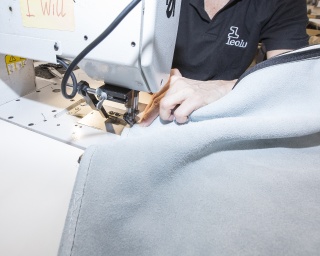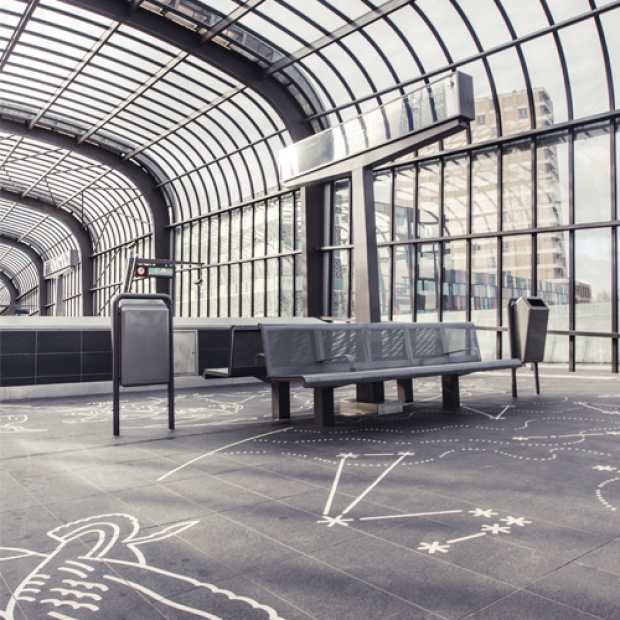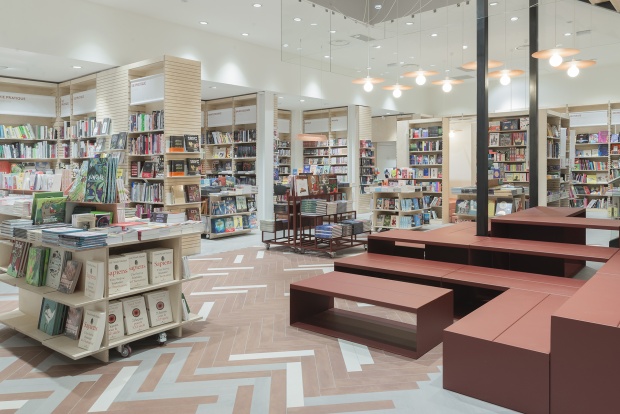with freelance
designers keeps us on our toes.’

Photography Sem Shayne
‘Since 2012, my business partner Patrick Schreudering and I have built on the company’s classic models, but we also have to go with the times,’ notes director Sebastiaan Sanders. ‘The market is evolving, and possibilities are changing, such as the use of online tools and social media as advertising platforms. Nowadays, much more is possible digitally compared with a few years ago. What’s more, customers are developing different needs. We adapt our collections to those changing needs by creating new designs that match the zeitgeist. Our customers can then use them as they please; after all, people will express their own identities whatever the timeframe. People use their cars, shoes, and interior furnishings to do so. We make that possible, because everything is possible when it comes to upholstery, colour, size, and comfort. We offer an almost infinite number of options that we can create within a few weeks.’
Sebastiaan Sanders, Director Leolux
Network organization
‘We aspire to be a stable organization that can quickly respond to what’s going on around it. We don’t want to be run in a hierarchical way as my grandfather and, to a lesser extent, my father did, but as a network organization in which everything is linked. There should be more horizontal connections with less control from upper levels of management. In doing so you can achieve more together, just like how ant colonies function.’


We produce all of our products in our own factories in Europe.
Brand strategy
‘We have been working with a multiple-brand strategy for a number of years now. Leolux is our oldest and best-known brand, but we also want to specifically target other customer groups as well. Pode is a young lifestyle brand that includes more trendy furniture and many accessories. Naturally, this appeals to a different kind of customer than our Évidence furniture, which is more conservative, focusing less on brand values and more on the right price-quality ratio. Recently, we started Leolux LX, helping architects and project designers to create interiors with their own identities. That’s a world entirely unto itself. What each of our brands conveys is so different, like the products in fact, but they all have our DNA.’

Dutch
‘For the past 85 years, we’ve been making our products at the same location. We’re proud of our history and the place where we started. Venlo’s location on the border is perfect for an exporting company. On the one hand, it makes us an international company and on the other we still have that real Dutch "no-nonsense" mentality. Additionally, we’re a real familyowned company, with loyal employees who have been with us for 30, 40, or even 50 years, spanning generations. Venlo, this place, is part of the company. What sets us apart from other companies in the furniture industry is that we do not outsource work to countries that pay low wages but produce all of our products in our own factories in Europe.’

Professionals
‘Skilled workers are the backbone of our company. Just as in other sectors like construction and education, we notice a growing shortage of skilled workers. These workers are increasingly hard to find in the Netherlands, and there are barely any study programmes from which we can source new employees. That is why, in the 90s, we moved our stitching work to our own factory in Szolnok in Hungary, an hour’s drive from Budapest. We primarily train our own upholsterers, which takes four or five years during which they study and work. We see it as a long-term investment and naturally want to ensure the people stay with us. And in the years to come, it will be challenging to fill the vacancies that open as a result of natural wastage. That’s why we’re trying to get young people excited about the manufacturing industry by holding talks at schools and offering work placements, for example.’
Just in time
‘On the one hand, we want to offer our customers a personal product quickly, meaning within six weeks. That’s our promise to customers. On the other, you don’t want to maintain massive stocks to meet such a multi-faceted demand, as this would lead to waste of valuable resources, energy, and capital. This happens regularly in the fashion industry, where containers full of clothing are destroyed because the model doesn’t sell quickly enough. We are totally against such destruction of capital, which is why we start producing when a client places an order and focus on just-in-time production. This ensures that the right components arrive at the right place at the right time. Essentially, it’s a question of good organization and enables us to run extremely efficient production processes.’

‘Our Pode art directors Roderick and Claire Vos designed an oriental-inspired side table made of ceramics, which is entirely glazed. We had no experience working with such materials, until now. That’s that advantage of working with external parties: they help us to expand our horizons.’
Sustainability
‘We focus on sustainability on a number of different levels in our company. It starts with the simple things close to home, such as solar panels on our roof to generate our own electricity, use of geothermal energy, good insulation, and use of LED lighting. We’re critical when it comes to which materials we use. We only use wooden sheet material with no added formaldehyde and water-based glue. Leather residues are repurposed, and the paper we use to print on is FSC certified. We also take our carbon footprint into account and look to use our products to ensure a better world for the next generations. We believe that quality contributes significantly to that goal. A wellmade product, constructed with high-quality and sustainably sourced resources, will last a long time and therefore place the smallest strain on the environment. We recently investigated how far we can go in that aspect. Our Hilco chair is designed locally, with development and production taking place in Venlo and all high-quality material sourced from the surrounding area. This means that we strengthen the local economy and that the resources travel a shorter distance compared with other products. The stand-out feature is the natural full grain leather, which is sourced from Limousin cattle in nature reserves in the region. The hides are tanned locally using a more environmentally friendly method. The person who purchases this chair also receives a code that reveals where the particular animal grazed. Leather is a fantastic material. In a way, our leather chair is a beautiful way of ‘upcycling’, given that it’s made from a residual product: the hides of cattle slaughtered for meat. Instead of the hides being thrown away, they’re used to make a strong and natural material for upholstery. We also offer a number of other materials besides leather, so our customers are really spoilt for choice!’


Customer needs
‘Our customers don’t buy what we sell; instead, we make what the customer wants. We also don’t ask the customer what chair they want but ask what they want to use the chair for. We’re witnessing a new idea of what makes a living room. The room used to be based around the TV, but with the arrival of Wi-Fi, portable devices, and TV on demand, people can now read an e-book or the online paper or watch the news anywhere in the home. We see an increasing number of people working from home and moving homes. Flexibility is becoming the standard, while furniture is becoming more compact and multifunctional. For instance, dining tables are now being used as desks. That’s why we sell a dining chair with extra functions, so that it works perfectly as a desk chair without looking like one. Another example is our Parabolica armchair. It has two sitting positions: one for laying back to relax while watching Netflix and one for sitting upright complete with a place to put your tablet.’
Design
‘The essence of design is to beautify functionality. Above all, design must be practical and contribute to the essence of the product. We think that the form should fit the product, as opposed to design for the sake of design. Our classic Pallone from 1989 is a great example of that belief. The seat and the back of the chair look splendid and are linked. The lines and contours are flawless and flow into one another. Everything is in balance, including the materials used, the height of the chair, and the slant of the legs. There’s not one element that appears wrong. Each aspect is an addition in itself and supplements the other aspects of the chair. Contrary to what you may expect from this design, the chair is also very comfortable to sit on’.

Freelance designers
‘For a long time, we’ve worked with a varying group of freelance designers. This ensures our flexibility and challenges us to constantly engage with new ideas. “In-house” designers tend to limit themselves after a while and may unintentionally close off new options. On the other hand, external designers create a design while being mindful of our brands, which often results in special associations or designs that forces us to bend over backwards to create the final product. But when we’ve done so, we end up three steps further than where we started, or we discover new possibilities. What could not be done in the past could be possible today with modern techniques. Additionally, our designers come from a range of countries and backgrounds. This means that they may view life, living, sitting, or materials in a different way, which keeps our brands fresh and diverse. As an example, the designer Gino Carollo views the world through Milanese eyes. He opts for southern luxury, which is more subdued and focused on the design, whereas a designer such as Frans Schrofer creates designs in the Dutch tradition, meaning that they are modest and emphasize the function.’



